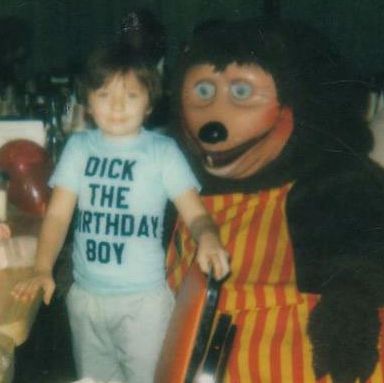
A puppy surrounded by two large snails. A bunch of spaghetti placed directly onto the glass of a photocopier. A man holding two hot dogs and crying as a dog’s eyes glow in the background. Web detritus? Creepy, “cursed” images? Both?
Recently, a Twitter account called @cursedimages has garnered some media attention — including write-ups in Gizmodo and The New Yorker. The gimmick of the account is simple: It posts unattributed photos and labels each one a “cursed image.” “Cursed image 3920” is a photo of a fiberglass-cow TV showing a news report about Saddam Hussein. “Cursed image 31” shows four boys around a computer.
What makes an image “cursed”? “Cursed images, to me, leave you with a general uneasy feeling,” the account’s anonymous author told Gizmodo. “There could be certain qualities, like someone looking directly at the camera or an orb floating in the background.”
This is an appealing idea — that there is something inherent to the subjects of the photographs that makes them “cursed” — but it doesn’t quite hold up to scrutiny. Take, for instance, @cursedimages’s interpretation of this photo, which they claim shows a lake with the “feeling” of “a kid diving too deep and never coming back up or someone seeing an unrecognizable creature swimming down with them in the depths.”
I don’t know. When I look at that photograph I just see a bunch of people going for a swim.
The cursed-image shtick has struck a chord on Twitter — the account has 101,000 followers — but it’s familiar to a lot of people as a long-running Tumblr joke: If you see a curious photo, you caption it “cursed image.” That’s it. Doug Battenhausen, an amateur archivist and the mind behind Internet History, a Tumblr of found photos that are interesting precisely because of their uninterestingness, told me, “If you were paying attention to Tumblr three years ago, a lot of [the photos on @cursedimages] would pop up,” he told me.
I don’t mean to be a spoilsport and ruin everyone’s spooky fun: The power of suggestion is real, and @CursedImages’ refusal to contextualize any of its images provides ample space for the imagination to run wild. But I wonder if there’s something else, besides the format, besides the subjects of the photos, that makes the account (and the images) so jarring to so many people.
I asked Battenhausen what the appeal of these found photos are. “It’s a lot of things,” he explained. “It’s the mystery of the photo, it’s the strange aesthetics of them, it’s seeing a place that you’ve never seen before, or an intimate glimpse into somebody’s life.” A lot of the photos on his blog are, or were, harvested from places like Flickr, and Photobucket, and the defunct Webshots. Relics from early Web 2.0, when uploading hundreds of publicly accessible photos taken with a point-and-shoot wasn’t a big deal. These sites were more for archival purposes than performative ones.
With the slow death of sites like Webshots, photos that reflected the world as it was are vanishing. Now, smartphone cameras have sharper images, and Instagram filters can make anything look appealing. Now, said Battenhausen, “Everybody knows that your internet life is so curated and monitored by everyone you know, and even strangers too, that you don’t want to come off looking silly.”
In some sense, “cursed” images are just old. The account @uncursedimages supplies sourcing for each of the photos, and for the most part, the actual origins are mundane. Take, for instance, a toilet filled with frogs. The actual culprit was flooding in Australia, and Reddit discussion on the pic is mostly about how much water damage the house endured. It’s funny, it’s curious, it’s odd. But it’s hardly “cursed.” And so it goes for nearly every image in the feed.
To that end, cursed images draw their power not from the actual objects pictured, but from the fact that photos like these are bygone products of antiquated technology. Millennials hardly use point-and-shoot cameras anymore, ones with blaring flashbulbs and obsolete sensors. Time stamps in bright orange or yellow text no longer adorn the corners of our shots. When people post photos on Facebook and Google now, the sites subtly tweak and enhance their colors, giving everything more “pop,” but less individuality.
This leaves old digital photos in an odd space — not old enough to scan as “vintage,” but not well-manicured enough to be recognizable as contemporary. When you see a film photo, you can tell its age. The effect is comforting. But digital photos from 2002 exist in an uncanny valley — lower in visual fidelity, and lacking a film grain to explain the reason for it. When everything is now airbrushed, and Facetuned, and dog-filtered, it’s no surprise that the impulse upon seeing a “cursed” image is to call it, well, cursed. But they’re really just relics of a bygone period of time, one that’s more recent than we remember.
To insist that these images are “cursed” because their subjects create an “uneasy” feeling misses the point. If they seem odd or jarring, it’s not because of anything inherent to them — they’re just photos of people living their lives — it’s because they’re images taken from the last cultural moment when photography was meant to faithfully record events, not elaborately perform them.





























